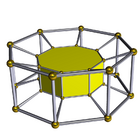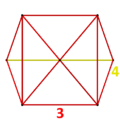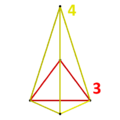4-8 duoprism
Uniform 4-8 duoprisms 140px 140pxSchlegel diagrams | |
|---|---|
| Type | Prismatic uniform polychoron |
| Schläfli symbols | {4}×{8} {4}×t{4} |
| Coxeter diagrams | |
| Cells | 4 octagonal prisms, 8 cubes |
| Faces | 32+8 squares, 4 octagons |
| Edges | 64 |
| Vertices | 32 |
| Vertex figure | Digonal disphenoid |
| Symmetry | [4,2,8], order 128 |
| Dual | 4-8 duopyramid |
| Properties | convex, vertex-uniform |
In geometry of 4 dimensions, a 4-8 duoprism, a duoprism and 4-polytope resulting from the Cartesian product of a square and an octagon.
It has 12 cells (4 octagonal prisms and 8 cubes), 44 faces (40 squares and 4 octagons), 64 edges, and 32 vertices.
Images
4-8 duopyramid
| 4-8 duopyramid | |
|---|---|
| Type | duopyramid |
| Schläfli symbol | {4}+{8} {4}+t{4} |
| Coxeter-Dynkin diagram | |
| Cells | 32 digonal disphenoids |
| Faces | 64 isosceles triangles |
| Edges | 44 (32+4+8) |
| Vertices | 12 (4+8) |
| Symmetry | [4,2,8], order 128 |
| Dual | 4-8 duoprism |
| Properties | convex, facet-transitive |
The dual of a 4-8 duoprism is called a 4-8 duopyramid. It has 32 tetragonal disphenoid cells, 64 isosceles triangular faces, 44 edges, and 12 vertices.
Related polytopes
The 2-4 duoantiprism is an alternation of the 4-8 duoprism, but is not uniform. It has a highest symmetry construction of order 64, with 28 cells composed of 4 square antiprisms and 24 tetrahedra (8 tetragonal disphenoids and 16 digonal disphenoids). There exists a construction with uniform square antiprisms with an edge length ratio of 1 : 1.189.

Vertex figure for the 2-4 duoantiprism
Also related is the bialternatosnub 2-4 duoprism, constructed by removing alternating long rectangles from the octagons, but is also not uniform. It has a highest symmetry construction of order 32, with 4 rectangular trapezoprisms (topologically equivalent to a cube but with D2d symmetry), 4 tetrahedra (as tetragonal disphenoids), with 8 triangular prisms (as C2v-symmetry wedges) filling the gaps. Its vertex figure is a Cs-symmetric triangular bipyramid.

Vertex figure for the bialternatosnub 2-4 duoprism
See also
- Polytope and polychoron
- Convex regular polychoron
- Duocylinder
- Tesseract
Notes
References
- Regular Polytopes, H. S. M. Coxeter, Dover Publications, Inc., 1973, New York, p. 124.
- Coxeter, The Beauty of Geometry: Twelve Essays, Dover Publications, 1999, ISBN:0-486-40919-8 (Chapter 5: Regular Skew Polyhedra in three and four dimensions and their topological analogues)
- Coxeter, H. S. M. Regular Skew Polyhedra in Three and Four Dimensions. Proc. London Math. Soc. 43, 33–62, 1937.
- John H. Conway, Heidi Burgiel, Chaim Goodman-Strass, The Symmetries of Things 2008, ISBN:978-1-56881-220-5 (Chapter 26)
- Norman Johnson Uniform Polytopes, Manuscript (1991)
- N. W. Johnson: The Theory of Uniform Polytopes and Honeycombs, Ph.D. Dissertation, University of Toronto, 1966
- Catalogue of Convex Polychora, section 6, George Olshevsky.
External links
- The Fourth Dimension Simply Explained—describes duoprisms as "double prisms" and duocylinders as "double cylinders"
- Polygloss – glossary of higher-dimensional terms
- Exploring Hyperspace with the Geometric Product


